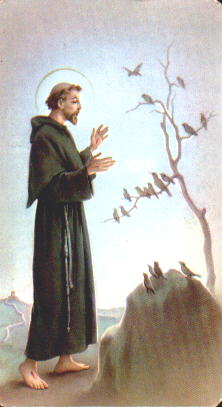
Feastday: October 4
Patron: of Animals, Merchants & Ecology
Birth: 1181
Death: 1226
Founder of the Franciscan Order, born at Assisi in Umbria, in 1181.
In 1182, Pietro Bernardone returned from a trip to France to find out his wife had given birth to a son. Far from being excited or apologetic because he'd been gone, Pietro was furious because she'd had his new son baptized Giovanni after John the Baptist. The last thing Pietro wanted in his son was a man of God -- he wanted a man of business, a cloth merchant like he was, and he especially wanted a son who would reflect his infatuation with France. So he renamed his son Francesco -- which is the equivalent of calling him Frenchman.
Francis enjoyed a very rich easy life growing up because of his father's wealth and the permissiveness of the times. From the beginning everyone -- and I mean everyone -- loved Francis. He was constantly happy, charming, and a born leader. If he was picky, people excused him. If he was ill, people took care of him. If he was so much of a dreamer he did poorly in school, no one minded. In many ways he was too easy to like for his own good. No one tried to control him or teach him.
As he grew up, Francis became the leader of a crowd of young people who spent their nights in wild parties. Thomas of Celano, his biographer who knew him well, said, "In other respects an exquisite youth, he attracted to himself a whole retinue of young people addicted to evil and accustomed to vice." Francis himself said, "I lived in sin" during that time.
Francis fulfilled every hope of Pietro's -- even falling in love with France. He loved the songs of France, the romance of France, and especially the free adventurous troubadours of France who wandered through Europe. And despite his dreaming, Francis was also good at business. But Francis wanted more..more than wealth. But not holiness! Francis wanted to be a noble, a knight. Battle was the best place to win the glory and prestige he longed for. He got his first chance when Assisi declared war on their longtime enemy, the nearby town of Perugia.
Most of the troops from Assisi were butchered in the fight. Only those wealthy enough to expect to be ransomed were taken prisoner. At last Francis was among the nobility like he always wanted to be...but chained in a harsh, dark dungeon. All accounts say that he never lost his happy manner in that horrible place. Finally, after a year in the dungeon, he was ransomed. Strangely, the experience didn't seem to change him. He gave himself to partying with as much joy and abandon as he had before the battle.
The experience didn't change what he wanted from life either: Glory. Finally a call for knights for the Fourth Crusade gave him a chance for his dream. But before he left Francis had to have a suit of armor and a horse -- no problem for the son of a wealthy father. And not just any suit of armor would do but one decorated with gold with a magnificent cloak. Any relief we feel in hearing that Francis gave the cloak to a poor knight will be destroyed by the boasts that Francis left behind that he would return a prince.
But Francis never got farther than one day's ride from Assisi. There he had a dream in which God told him he had it all wrong and told him to return home. And return home he did. What must it have been like to return without ever making it to battle -- the boy who wanted nothing more than to be liked was humiliated, laughed at, called a coward by the village and raged at by his father for the money wasted on armor.
Francis' conversion did not happen over night. God had waited for him for twenty-five years and now it was Francis' turn to wait. Francis started to spend more time in prayer. He went off to a cave and wept for his sins. Sometimes God's grace overwhelmed him with joy. But life couldn't just stop for God. There was a business to run, customers to wait on.
One day while riding through the countryside, Francis, the man who loved beauty, who was so picky about food, who hated deformity, came face to face with a leper. Repelled by the appearance and the smell of the leper, Francis nevertheless jumped down from his horse and kissed the hand of the leper. When his kiss of peace was returned, Francis was filled with joy. As he rode off, he turned around for a last wave, and saw that the leper had disappeared. He always looked upon it as a test from God...that he had passed.
His search for conversion led him to the ancient church at San Damiano. While he was praying there, he heard Christ on the crucifix speak to him, "Francis, repair my church." Francis assumed this meant church with a small c -- the crumbling building he was in. Acting again in his impetuous way, he took fabric from his father's shop and sold it to get money to repair the church. His father saw this as an act of theft -- and put together with Francis' cowardice, waste of money, and his growing disinterest in money made Francis seem more like a madman than his son. Pietro dragged Francis before the bishop and in front of the whole town demanded that Francis return the money and renounce all rights as his heir.
The bishop was very kind to Francis; he told him to return the money and said God would provide. That was all Francis needed to hear. He not only gave back the money but stripped off all his clothes -- the clothes his father had given him -- until he was wearing only a hair shirt. In front of the crowd that had gathered he said, "Pietro Bernardone is no longer my father. From now on I can say with complete freedom, 'Our Father who art in heaven.'" Wearing nothing but castoff rags, he went off into the freezing woods -- singing. And when robbers beat him later and took his clothes, he climbed out of the ditch and went off singing again. From then on Francis had nothing...and everything.
Francis went back to what he considered God's call. He begged for stones and rebuilt the San Damiano church with his own hands, not realizing that it was the Church with a capital C that God wanted repaired. Scandal and avarice were working on the Church from the inside while outside heresies flourished by appealing to those longing for something different or adventurous.
Soon Francis started to preach. (He was never a priest, though he was later ordained a deacon under his protest.) Francis was not a reformer; he preached about returning to God and obedience to the Church. Francis must have known about the decay in the Church, but he always showed the Church and its people his utmost respect. When someone told him of a priest living openly with a woman and asked him if that meant the Mass was polluted, Francis went to the priest, knelt before him, and kissed his hands -- because those hands had held God.
Slowly companions came to Francis, people who wanted to follow his life of sleeping in the open, begging for garbage to eat...and loving God. With companions, Francis knew he now had to have some kind of direction to this life so he opened the Bible in three places. He read the command to the rich young man to sell all his good and give to the poor, the order to the apostles to take nothing on their journey, and the demand to take up the cross daily. "Here is our rule," Francis said -- as simple, and as seemingly impossible, as that. He was going to do what no one thought possible any more -- live by the Gospel. Francis took these commands so literally that he made one brother run after the thief who stole his hood and offer him his robe!
Francis never wanted to found a religious order -- this former knight thought that sounded too military. He thought of what he was doing as expressing God's brotherhood. His companions came from all walks of life, from fields and towns, nobility and common people, universities, the Church, and the merchant class. Francis practiced true equality by showing honor, respect, and love to every person whether they were beggar or pope.
Francis' brotherhood included all of God's creation. Much has been written about Francis' love of nature but his relationship was deeper than that. We call someone a lover of nature if they spend their free time in the woods or admire its beauty. But Francis really felt that nature, all God's creations, were part of his brotherhood. The sparrow was as much his brother as the pope.
In one famous story, Francis preached to hundreds of birds about being thankful to God for their wonderful clothes, for their independence, and for God's care. The story tells us the birds stood still as he walked among him, only flying off when he said they could leave.
Another famous story involves a wolf that had been eating human beings. Francis intervened when the town wanted to kill the wolf and talked the wolf into never killing again. The wolf became a pet of the townspeople who made sure that he always had plenty to eat.
Following the Gospel literally, Francis and his companions went out to preach two by two. At first, listeners were understandably hostile to these men in rags trying to talk about God's love. People even ran from them for fear they'd catch this strange madness! And they were right. Because soon these same people noticed that these barefoot beggars wearing sacks seemed filled with constant joy. They celebrated life. And people had to ask themselves: Could one own nothing and be happy? Soon those who had met them with mud and rocks, greeted them with bells and smiles.
Francis did not try to abolish poverty, he tried to make it holy. When his friars met someone poorer than they, they would eagerly rip off the sleeve of their habit to give to the person. They worked for all necessities and only begged if they had to. But Francis would not let them accept any money. He told them to treat coins as if they were pebbles in the road. When the bishop showed horror at the friars' hard life, Francis said, "If we had any possessions we should need weapons and laws to defend them." Possessing something was the death of love for Francis. Also, Francis reasoned, what could you do to a man who owns nothing? You can't starve a fasting man, you can't steal from someone who has no money, you can't ruin someone who hates prestige. They were truly free.
Francis was a man of action. His simplicity of life extended to ideas and deeds. If there was a simple way, no matter how impossible it seemed, Francis would take it. So when Francis wanted approval for his brotherhood, he went straight to Rome to see Pope Innocent III. You can imagine what the pope thought when this beggar approached him! As a matter of fact he threw Francis out. But when he had a dream that this tiny man in rags held up the tilting Lateran basilica, he quickly called Francis back and gave him permission to preach.
Sometimes this direct approach led to mistakes that he corrected with the same spontaneity that he made them. Once he ordered a brother who hesitated to speak because he stuttered to go preach half-naked. When Francis realized how he had hurt someone he loved he ran to town, stopped the brother, took off his own clothes, and preached instead.
Francis acted quickly because he acted from the heart; he didn't have time to put on a role. Once he was so sick and exhausted, his companions borrowed a mule for him to ride. When the man who owned the mule recognized Francis he said, "Try to be as virtuous as everyone thinks you are because many have a lot of confidence in you." Francis dropped off the mule and knelt before the man to thank him for his advice.
Another example of his directness came when he decided to go to Syria to convert the Moslems while the Fifth Crusade was being fought. In the middle of a battle, Francis decided to do the simplest thing and go straight to the sultan to make peace. When he and his companion were captured, the real miracle was that they weren't killed. Instead Francis was taken to the sultan who was charmed by Francis and his preaching. He told Francis, "I would convert to your religion which is a beautiful one -- but both of us would be murdered."
Francis did find persecution and martyrdom of a kind -- not among the Moslems, but among his own brothers. When he returned to Italy, he came back to a brotherhood that had grown to 5000 in ten years. Pressure came from outside to control this great movement, to make them conform to the standards of others. His dream of radical poverty was too harsh, people said. Francis responded, "Lord, didn't I tell you they wouldn't trust you?"
He finally gave up authority in his order -- but he probably wasn't too upset about it. Now he was just another brother, like he'd always wanted.
Francis' final years were filled with suffering as well as humiliation. Praying to share in Christ's passion he had a vision received the stigmata, the marks of the nails and the lance wound that Christ suffered, in his own body.
Years of poverty and wandering had made Francis ill. When he began to go blind, the pope ordered that his eyes be operated on. This meant cauterizing his face with a hot iron. Francis spoke to "Brother Fire": "Brother Fire, the Most High has made you strong and beautiful and useful. Be courteous to me now in this hour, for I have always loved you, and temper your heat so that I can endure it." And Francis reported that Brother Fire had been so kind that he felt nothing at all.
How did Francis respond to blindness and suffering? That was when he wrote his beautiful Canticle of the Sun that expresses his brotherhood with creation in praising God.
Francis never recovered from this illness. He died on October 4, 1226 at the age of 45. Francis is considered the founder of all Franciscan orders and the patron saint of ecologists and merchants.
Italian Catholic saint, friar, deacon and preacher and founder of the Franciscan Order (1181/2–1226) This article is about the friar and patron saint. For other uses, see Francis of Assisi (disambiguation).
 The oldest surviving depiction of St. Francis is a fresco near the entrance of the Benedictine abbey of Subiaco, painted between March 1228 and March 1229. He is depicted without the stigmata, but the image is a religious image and not a portrait.
The oldest surviving depiction of St. Francis is a fresco near the entrance of the Benedictine abbey of Subiaco, painted between March 1228 and March 1229. He is depicted without the stigmata, but the image is a religious image and not a portrait.
| Part of a series on | |||||||||||||||||||||||||||||
| Christian mysticism | |||||||||||||||||||||||||||||
|---|---|---|---|---|---|---|---|---|---|---|---|---|---|---|---|---|---|---|---|---|---|---|---|---|---|---|---|---|---|
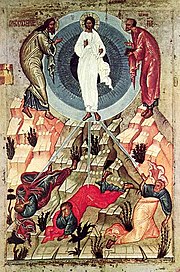 | |||||||||||||||||||||||||||||
Theology · Philosophy
|
|||||||||||||||||||||||||||||
Practices
|
|||||||||||||||||||||||||||||
People (by era or century)
|
|||||||||||||||||||||||||||||
Literature · Media
|
|||||||||||||||||||||||||||||
|
| Part of a series on |
| Eucharistic adoration of the Catholic Church |
|---|
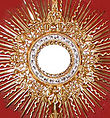 Solar monstrance of the Eucharist Solar monstrance of the Eucharist |
| Papal documents |
|
| Organisations and events |
|
| Notable individuals |
|
| Eucharistic meditators |
|
|
|
|
Francis of Assisi (born Giovanni di Pietro di Bernardone; Italian: Francesco d'Assisi; Latin: Franciscus Assisiensis; 1181 or 1182 – 3 October 1226), venerated as Saint Francis of Assisi, also known in his ministry as Francesco, was an Italian Catholic friar, deacon, mystic, and preacher. He founded the men's Order of Friars Minor, the women's Order of St. Clare, the Third Order of St. Francis and the Custody of the Holy Land. Francis is one of the most venerated religious figures in Christianity.
Pope Gregory IX canonized Francis on 16 July 1228. Along with Catherine of Siena, he was designated patron saint of Italy. He later became associated with patronage of animals and the natural environment, and it became customary for churches to hold ceremonies blessing animals on or near his feast day of 4 October. In 1219, he went to Egypt in an attempt to convert the Sultan to put an end to the conflict of the Crusades. By this point, the Franciscan Order had grown to such an extent that its primitive organizational structure was no longer sufficient. He returned to Italy to organize the order. Once his community was authorized by the Pope, he withdrew increasingly from external affairs.
Francis is known for his love of the Eucharist. In 1223, Francis arranged for the first Christmas live nativity scene. According to Christian tradition, in 1224 he received the stigmata during the apparition of a Seraphic angel in a religious ecstasy, which would make him the first person in Christian tradition to bear the wounds of Christ's Passion. He died during the evening hours of 3 October 1226, while listening to a reading he had requested of Psalm 142 (141).
Biography
Early life
Francis of Assisi was born in late 1181 or early 1182, one of several children of an Italian father, Pietro di Bernardone dei Moriconi, a prosperous silk merchant, and a French mother, Pica de Bourlemont, about whom little is known except that she was a noblewoman originally from Provence. Pietro was in France on business when Francis was born in Assisi, and Pica had him baptized as Giovanni. Upon his return to Assisi, Pietro took to calling his son Francesco ("the Frenchman"), possibly in honor of his commercial success and enthusiasm for all things French. Since the child was renamed in infancy, the change can hardly have had anything to do with his aptitude for learning French, as some have thought.
Indulged by his parents, Francis lived the high-spirited life typical of a wealthy young man. As a youth, Francesco became a devotee of troubadours and was fascinated with all things Transalpine. He was handsome, witty, gallant, and delighted in fine clothes. He spent money lavishly. Although many hagiographers remark about his bright clothing, rich friends, and love of pleasures, his displays of disillusionment toward the world that surrounded him came fairly early in his life, as is shown in the "story of the beggar". In this account, he was selling cloth and velvet in the marketplace on behalf of his father when a beggar came to him and asked for alms. At the conclusion of his business deal, Francis abandoned his wares and ran after the beggar. When he found him, Francis gave the man everything he had in his pockets. His friends mocked him for his charity; his father scolded him in rage.
Around 1202, he joined a military expedition against Perugia and was taken as a prisoner at Collestrada, spending a year as a captive. An illness caused him to re-evaluate his life. Upon his return to Assisi in 1203, Francis returned to his carefree life. In 1205, Francis left for Apulia to enlist in the army of Walter III, Count of Brienne. A strange vision made him return to Assisi and lose interest in the worldly life. According to hagiographic accounts, thereafter he began to avoid the sports and the feasts of his former companions. A friend asked him whether he was thinking of marrying, to which he answered: "Yes, a fairer bride than any of you have ever seen", meaning his "Lady Poverty".
On a pilgrimage to Rome, he joined the poor in begging at St. Peter's Basilica. He spent some time in lonely places, asking God for spiritual enlightenment. He said he had a mystical vision of Jesus Christ in the forsaken country chapel of San Damiano, just outside Assisi, in which the Icon of Christ Crucified said to him, "Francis, Francis, go and repair My house which, as you can see, is falling into ruins." He took this to mean the ruined church in which he was presently praying, and so he sold some cloth from his father's store to assist the priest there for this purpose. When the priest refused to accept the ill-gotten gains, an indignant Francis threw the coins on the floor.
In order to avoid his father's wrath, Francis hid in a cave near San Damiano for about a month. When he returned to town, hungry and dirty, he was dragged home by his father, beaten, bound, and locked in a small storeroom. Freed by his mother during Bernardone's absence, Francis returned at once to San Damiano, where he found shelter with the officiating priest, but he was soon cited before the city consuls by his father. The latter, not content with having recovered the scattered gold from San Damiano, sought also to force his son to forego his inheritance by way of restitution. In the midst of legal proceedings before the Bishop of Assisi, Francis renounced his father and his patrimony. Some accounts report that he stripped himself naked in token of this renunciation, and the bishop covered him with his own cloak.
For the next couple of months, Francis wandered as a beggar in the hills behind Assisi. He spent some time at a neighbouring monastery working as a scullion. He then went to Gubbio, where a friend gave him, as an alms, the cloak, girdle, and staff of a pilgrim. Returning to Assisi, he traversed the city begging stones for the restoration of St. Damiano's. These he carried to the old chapel, set in place himself, and so at length rebuilt it. Over the course of two years, he embraced the life of a penitent, during which he restored several ruined chapels in the countryside around Assisi, among them San Pietro in Spina (in the area of San Petrignano in the valley about a kilometer from Rivotorto, today on private property and once again in ruin); and the Porziuncola, the little chapel of St. Mary of the Angels in the plain just below the town. This later became his favorite abode. By degrees he took to nursing lepers, in the lazar houses near Assisi.
-

The house where Francis of Assisi lived when young
-
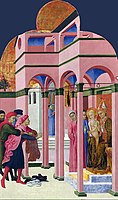
Saint Francis denies his earthly father.
Founding of the Franciscan Orders
The Friars Minor
One morning in February 1208, Francis was taking part in a Mass in the chapel of St. Mary of the Angels, near which he had by then built himself a hut. The Gospel of the day was the "Commissioning of the Twelve" from the Book of Matthew. The disciples are to go and proclaim that the Kingdom of God is at hand. Francis was inspired to devote himself to a life of poverty. Having obtained a coarse woolen tunic, the dress then worn by the poorest Umbrian peasants, he tied it around himself with a knotted rope and went about exhorting the people of the countryside to penance, brotherly love, and peace. Francis's preaching to ordinary people was unusual as he had no license to do so.
His example attracted others. Within a year Francis had eleven followers. The brothers lived a simple life in the deserted lazar house of Rivo Torto near Assisi; but they spent much of their time wandering through the mountainous districts of Umbria, making a deep impression upon their hearers by their earnest exhortations.
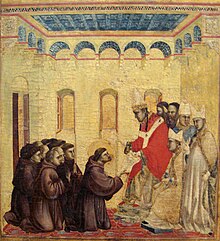 Pope Innocent III approving the statutes of the Order of the Franciscans, by Giotto, 1295–1300
Pope Innocent III approving the statutes of the Order of the Franciscans, by Giotto, 1295–1300
In 1209 he composed a simple rule for his followers ("friars"), the Regula primitiva or "Primitive Rule", which came from verses in the Bible. The rule was "To follow the teachings of our Lord Jesus Christ and to walk in his footsteps". He then led his first eleven followers to Rome to seek permission from Pope Innocent III to found a new religious order. Upon entry to Rome, the brothers encountered Bishop Guido of Assisi, who had in his company Giovanni di San Paolo, the Cardinal Bishop of Sabina. The Cardinal, who was the confessor of Pope Innocent III, was immediately sympathetic to Francis and agreed to represent Francis to the pope. Reluctantly, Pope Innocent agreed to meet with Francis and the brothers the next day. After several days, the pope agreed to admit the group informally, adding that when God increased the group in grace and number, they could return for an official admittance. The group was tonsured. This was important in part because it recognized Church authority and prevented his following from accusations of heresy, as had happened to the Waldensians decades earlier. Though a number of the pope's counselors considered the mode of life proposed by Francis as unsafe and impractical, following a dream in which he saw Francis holding up the Lateran Basilica (the cathedral of Rome, thus the 'home church' of all Christendom), he decided to endorse Francis's order. This occurred, according to tradition, on 16 April 1210, and constituted the official founding of the Franciscan Order. The group, then the "Lesser Brothers" (Order of Friars Minor also known as the Franciscan Order or the Seraphic Order), were centered in the Porziuncola and preached first in Umbria, before expanding throughout Italy. Francis chose never to be ordained a priest, although he was later ordained a deacon.
The Poor Clares and the Third Order
From then on, the new order grew quickly with new vocations. Hearing Francis preaching in the church of San Rufino in Assisi in 1211, the young noblewoman Clare of Assisi sought to live like Francis. Her cousin Rufino also sought to join him. On the night of Palm Sunday, 28 March 1212, Clare clandestinely left her family's palace. Francis received her at the Porziuncola and thereby established the Order of Poor Ladies. He gave Clare a religious habit, a garment similar to his own, before lodging her, her younger sister Caterina, and other young women in a nearby monastery of Benedictine nuns until he could provide a suitable retreat for her, and for who had joined her. Later he transferred them to San Damiano, to a few small huts or cells. This became the first monastery of the Second Franciscan Order, now known as Poor Clares.
For those who could not leave their homes, Francis later formed the Third Order of Brothers and Sisters of Penance, a fraternity composed of either laity or clergy whose members neither withdrew from the world nor took religious vows. Instead, they observed the principles of Franciscan life in their daily lives. Before long, this Third Order grew beyond Italy. The Third Order is now titled the Secular Franciscan Order.
Travels
Determined to bring the Gospel to all peoples and convert them, Francis sought on several occasions to take his message out of Italy. In the late spring of 1212, he set out for Jerusalem, but was shipwrecked by a storm on the Dalmatian coast, forcing him to return to Italy. On 8 May 1213, he was given the use of the mountain of La Verna (Alverna) as a gift from Count Orlando di Chiusi, who described it as “eminently suitable for whoever wishes to do penance in a place remote from mankind”. The mountain would become one of his favourite retreats for prayer.
In the same year, Francis sailed for Morocco, but an illness forced him to break off his journey while in Spain.
In 1219, accompanied by another friar and hoping to convert the Sultan of Egypt or be martyred in the attempt, Francis went to Egypt during the Fifth Crusade where a Crusader army had been encamped for over a year besieging the walled city of Damietta. The Sultan, al-Kamil, a nephew of Saladin, had succeeded his father as Sultan of Egypt in 1218 and was encamped upstream of Damietta. A bloody and futile attack on the city was launched by the Christians on 29 August 1219, following which both sides agreed to a ceasefire which lasted four weeks. It was most probably during this interlude that Francis and his companion crossed the Muslims' lines and were brought before the Sultan, remaining in his camp for a few days. Reports give no information about what transpired during the encounter beyond noting that the Sultan received Francis graciously and that Francis preached to the Muslims. He returned unharmed. No known Arab sources mention the visit.
 Francis and others treating victims of leprosy or smallpox
Francis and others treating victims of leprosy or smallpox
Such an incident is alluded to in a scene in the late 13th-century fresco cycle, attributed to Giotto, in the upper basilica at Assisi.
According to some late sources, the Sultan gave Francis permission to visit the sacred places in the Holy Land and even to preach there. All that can safely be asserted is that Francis and his companion left the Crusader camp for Acre, from where they embarked for Italy in the latter half of 1220. Drawing on a 1267 sermon by Bonaventure, later sources report that the Sultan secretly converted or accepted a death-bed baptism as a result of meeting Francis.
Due to these events in Jerusalem, Franciscans have been present in the Holy Land almost uninterruptedly since 1217. They received concessions from the Mameluke Sultan in 1333 with regard to certain Holy Places in Jerusalem and Bethlehem, and (so far as concerns the Catholic Church) jurisdictional privileges from Pope Clement VI in 1342.
Reorganization of the Franciscan Order
 St. Francis preaching to the birds outside of Bevagna (Master of St. Francis).
St. Francis preaching to the birds outside of Bevagna (Master of St. Francis).The growing order of friars was divided into provinces; groups were sent to France, Germany, Hungary, and Spain and to the East. Upon receiving a report of the martyrdom of five brothers in Morocco, Francis returned to Italy via Venice. Cardinal Ugolino di Conti was then nominated by the pope as the protector of the order. Another reason for Francis' return to Italy was that the Franciscan Order had grown at an unprecedented rate compared to previous religious orders, but its organizational sophistication had not kept up with this growth and had little more to govern it than Francis' example and simple rule. To address this problem, Francis prepared a new and more detailed Rule, the "First Rule" or "Rule Without a Papal Bull" (Regula prima, Regula non bullata), which again asserted devotion to poverty and the apostolic life. However, it also introduced greater institutional structure, though this was never officially endorsed by the pope.
On 29 September 1220, Francis handed over the governance of the order to Brother Peter Catani at the Porziuncola, but Peter died only five months later.
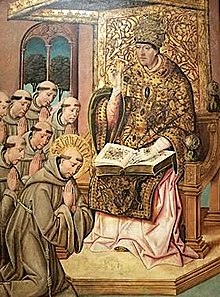 Honorius III Approving the Rule of St. Francis of Assisi, Bartolome del Castro, c. 1500 (Philadelphia Museum of Art)
Honorius III Approving the Rule of St. Francis of Assisi, Bartolome del Castro, c. 1500 (Philadelphia Museum of Art)
Brother Peter was succeeded by Brother Elias as Vicar of Francis. Two years later, Francis modified the "First Rule", creating the "Second Rule" or "Rule With a Bull", which was approved by Pope Honorius III on 29 November 1223. As the order's official rule, it called on the friars "to observe the Holy Gospel of our Lord Jesus Christ, living in obedience without anything of our own and in chastity". In addition, it set regulations for discipline, preaching, and entering the order. Once the rule was endorsed by the pope, Francis withdrew increasingly from external affairs. During 1221 and 1222, he crossed Italy, first as far south as Catania in Sicily and afterward as far north as Bologna.
Stigmata, final days, and sainthood
 Francis considered his stigmata part of the Imitation of Christ. Cigoli, 1699
Francis considered his stigmata part of the Imitation of Christ. Cigoli, 1699
While he was praying on the mountain of Verna, during a forty-day fast in preparation for Michaelmas (29 September), Francis is said to have had a vision on or about 13 September 1224, the Feast of the Exaltation of the Cross, as a result of which he received the stigmata. Brother Leo, who had been with Francis at the time, left a clear and simple account of the event, the first definite account of the phenomenon of stigmata. "Suddenly he saw a vision of a seraph, a six-winged angel on a cross. This angel gave him the gift of the five wounds of Christ." Suffering from these stigmata and from trachoma, Francis received care in several cities (Siena, Cortona, Nocera) to no avail. In the end, he was brought back to a hut next to the Porziuncola. Here he spent his last days dictating his spiritual testament. He died on the evening of Saturday, 3 October 1226, singing Psalm 141, "Voce mea ad Dominum".
On 16 July 1228, he was pronounced a saint by Pope Gregory IX (the former cardinal Ugolino di Conti, a friend of Francis and Cardinal Protector of the Order). The next day, the pope laid the foundation stone for the Basilica of St. Francis in Assisi. Francis was buried on 25 May 1230, under the Lower Basilica, but his tomb was soon hidden on orders of Brother Elias to protect it from Saracen invaders. His burial place remained unknown until it was rediscovered in 1818. Pasquale Belli then constructed for the remains a crypt in the Lower Basilica. It was refashioned between 1927 and 1930 into its present form by Ugo Tarchi. In 1978, the remains of Francis were examined and confirmed by a commission of scholars appointed by Pope Paul VI, and put into a glass urn in the ancient stone tomb.
Character and legacy
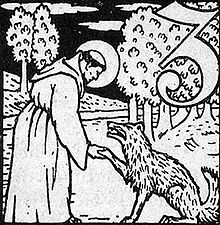 St. Francis talking to the wolf of Gubbio (Carl Weidemeyer, 1911)
St. Francis talking to the wolf of Gubbio (Carl Weidemeyer, 1911)
Francis set out to imitate Christ and literally carry out his work. This is important in understanding Francis' character, his affinity for the Eucharist and respect for the priests who carried out the sacrament. He preached: "Your God is of your flesh, He lives in your nearest neighbor, in every man."
He and his followers celebrated and even venerated poverty, which was so central to his character that in his last written work, the Testament, he said that absolute personal and corporate poverty was the essential lifestyle for the members of his order.
He believed that nature itself was the mirror of God. He called all creatures his "brothers" and "sisters", and even preached to the birds and supposedly persuaded a wolf in Gubbio to stop attacking some locals if they agreed to feed the wolf. His deep sense of brotherhood under God embraced others, and he declared that "he considered himself no friend of Christ if he did not cherish those for whom Christ died".
Francis' visit to Egypt and attempted rapprochement with the Muslim world had far-reaching consequences, long past his own death, since after the fall of the Crusader Kingdom, it would be the Franciscans, of all Catholics, who would be allowed to stay on in the Holy Land and be recognized as "Custodians of the Holy Land" on behalf of the Catholic Church.
At Greccio near Assisi, around 1220, Francis celebrated Christmas by setting up the first known presepio or crèche (Nativity scene). His nativity imagery reflected the scene in traditional paintings. He used real animals to create a living scene so that the worshipers could contemplate the birth of the child Jesus in a direct way, making use of the senses, especially sight. Both Thomas of Celano and Bonaventure, biographers of Francis, tell how he used only a straw-filled manger (feeding trough) set between a real ox and donkey. According to Thomas, it was beautiful in its simplicity, with the manger acting as the altar for the Christmas Mass.
Nature and the environment
See also: Wolf of Gubbio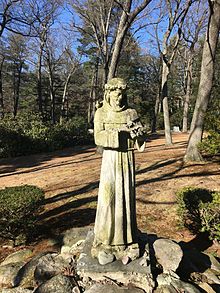 A garden statue of Francis of Assisi with birds
A garden statue of Francis of Assisi with birds
Francis preached the Christian doctrine that the world was created good and beautiful by God but suffers a need for redemption because of human sin. As someone who saw God reflected in nature, "St. Francis was a great lover of God's creation ..." In the Canticle of the Sun he gives God thanks for Brother Sun, Sister Moon, Brother Wind, Water, Fire, and Earth, all of which he sees as rendering praise to God.
Many of the stories that surround the life of Francis say that he had a great love for animals and the environment. The "Fioretti" ("Little Flowers"), is a collection of legends and folklore that sprang up after his death. One account describes how one day, while Francis was traveling with some companions, they happened upon a place in the road where birds filled the trees on either side. Francis told his companions to "wait for me while I go to preach to my sisters the birds." The birds surrounded him, intrigued by the power of his voice, and not one of them flew away. He is often portrayed with a bird, typically in his hand.
Another legend from the Fioretti tells that in the city of Gubbio, where Francis lived for some time, was a wolf "terrifying and ferocious, who devoured men as well as animals". Francis went up into the hills and when he found the wolf, he made the sign of the cross and commanded the wolf to come to him and hurt no one. Then Francis led the wolf into the town, and surrounded by startled citizens made a pact between them and the wolf. Because the wolf had “done evil out of hunger, the townsfolk were to feed the wolf regularly. In return, the wolf would no longer prey upon them or their flocks. In this manner Gubbio was freed from the menace of the predator.
On 29 November 1979, Pope John Paul II declared Francis the patron saint of ecology. On 28 March 1982, John Paul II said that Francis' love and care for creation was a challenge for contemporary Catholics and a reminder "not to behave like dissident predators where nature is concerned, but to assume responsibility for it, taking all care so that everything stays healthy and integrated, so as to offer a welcoming and friendly environment even to those who succeed us." The same Pope wrote on the occasion of the World Day of Peace, 1 January 1990, that Francis "invited all of creation – animals, plants, natural forces, even Brother Sun and Sister Moon – to give honor and praise to the Lord. The poor man of Assisi gives us striking witness that when we are at peace with God we are better able to devote ourselves to building up that peace with all creation which is inseparable from peace among all peoples."
It is a popular practice on his feastday, 4 October, for people to bring their pets and other animals to church for a blessing.
Feast day
 Francis' last resting place at Assisi
Francis' last resting place at Assisi
Francis' feast day is observed on 4 October. A secondary feast in honor of the stigmata received by Francis, celebrated on 17 September, was inserted in the General Roman Calendar in 1585 (later than the Tridentine Calendar) and suppressed in 1604, but was restored in 1615. In the New Roman Missal of 1969, it was removed again from the General Calendar, as something of a duplication of the main feast on 4 October, and left to the calendars of certain localities and of the Franciscan Order. Wherever the Trindentine Missal is used, however, the feast of the Stigmata remains in the General Calendar.
Francis is honored with a Lesser Festival in the Church of England, the Anglican Church of Canada, the Episcopal Church USA, the Old Catholic Churches, the Evangelical Lutheran Church in America, and other churches and religious communities on 4 October.
Papal name
On 13 March 2013, upon his election as Pope, Archbishop and Cardinal Jorge Mario Bergoglio of Argentina chose Francis as his papal name in honor of Francis of Assisi, becoming Pope Francis.
At his first audience on 16 March 2013, Pope Francis told journalists that he had chosen the name in honor of Francis of Assisi, and had done so because he was especially concerned for the well-being of the poor. The pontiff recounted that Cardinal Cláudio Hummes had told him, "Don't forget the poor", right after the election; that made Bergoglio think of Francis. It is the first time a pope has taken the name.
Patronage
 A relic of Francis of Assisi
A relic of Francis of Assisi
| This section needs additional citations for verification. (October 2017) |
On 18 June 1939, Pope Pius XII named Francis a joint Patron Saint of Italy along with Catherine of Siena with the apostolic letter "Licet Commissa". Pope Pius also mentioned the two saints in the laudative discourse he pronounced on 5 May 1949, in the Church of Santa Maria Sopra Minerva.
Francis is the patron of animals, merchants, and ecology. He is also considered the patron against dying alone; against fire; patron of the Franciscan Order and Catholic Action; of families, peace, and needleworkers. He is the patron of many dioceses and other locations around the world, including: Italy; San Pawl il-Bahar, Malta; Freising, Germany; Lancaster, England; Kottapuram, India; San Francisco de Malabon, Philippines (General Trias City); San Francisco, California; Santa Fe, New Mexico; Colorado; Salina, Kansas; Metuchen, New Jersey; and Quibdó, Colombia.
Outside Catholicism
Protestantism
Main article: Franciscan spirituality in ProtestantismSeveral Protestant groups have emerged since the 19th century that strive to adhere to the teachings of St. Francis.
One of the results of the Oxford Movement in the Anglican Church during the 19th century was the re-establishment of religious orders, including some of Franciscan inspiration. The principal Anglican communities in the Franciscan tradition are the Community of St. Francis (women, founded 1905), the Poor Clares of Reparation (P.C.R.), the Society of St. Francis (men, founded 1934), and the Community of St. Clare (women, enclosed).
A U.S.-founded order within the Anglican world communion is the Seattle-founded order of Clares in Seattle (Diocese of Olympia), The Little Sisters of St. Clare.
There are also some small Franciscan communities within European Protestantism and the Old Catholic Church. There are some Franciscan orders in Lutheran Churches, including the Order of Lutheran Franciscans, the Evangelical Sisterhood of Mary, and the Evangelische Kanaan Franziskus-Bruderschaft (Kanaan Franciscan Brothers).
The Anglican church retained the Catholic tradition of blessing animals on or near Francis' feast day of 4 October, and more recently Lutheran and other Protestant churches have adopted the practice.
Orthodox churches
Francis' feast is celebrated at New Skete, an Orthodox Christian monastic community in Cambridge, New York.
Other faiths
Outside of Christianity, other individuals and movements are influenced by the example and teachings of Francis. These include the popular philosopher Eckhart Tolle, who has made videos on the spirituality of Francis.
The interfaith spiritual community of Skanda Vale also takes inspiration from the example of Francis, and models itself as an interfaith Franciscan order.
Main writings
- Canticum Fratris Solis or Laudes Creaturarum; Canticle of the Sun
- Prayer before the Crucifix, 1205 (extant in the original Umbrian dialect as well as in a contemporary Latin translation)
- Regula non bullata, the Earlier Rule, 1221
- Regula bullata, the Later Rule, 1223
- Testament, 1226
- Admonitions
For a complete list, see The Franciscan Experience.
Francis is considered the first Italian poet by some literary critics. He believed commoners should be able to pray to God in their own language, and he wrote often in the dialect of Umbria instead of Latin.
The anonymous 20th-century prayer "Make Me an Instrument of Your Peace" is widely attributed to Francis, but there is no evidence for it.
In art
The Franciscan Order promoted devotion to the life of Francis from his canonization onwards. The order commissioned many works for Franciscan churches, either showing him with sacred figures, or episodes from his life. There are large early fresco cycles in the Basilica of San Francesco d'Assisi, parts of which are shown above.
There are countless seventeenth- and eighteenth-century depictions of Saint Francis of Assisi and a musical angel in churches and museums throughout western Europe. The titles of these depictions vary widely, at times describing Francis as “consoled,” “comforted,” in “ecstasy,” or in “rapture”; the presence of the musical angel may or may not be mentioned.
- Francis of Assisi in art
-
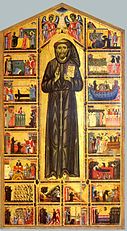
St. Francis and scenes from his life, 13th century
-

Saint Francis of Assisi Receiving the Stigmata, Jan van Eyck, c. 1430–1432, Turin version
-

The Stigmatization of St Francis, Domenico Veneziano, 1445
-

Saint Francis in the Desert Giovanni Bellini, c. 1480
-
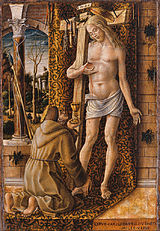
Saint Francis with the Blood of Christ, Carlo Crivelli, c. 1500
-

Saint Francis Receiving the Stigmata, Studio of El Greco, 1585–1590
-
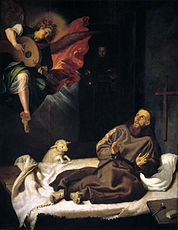
Francis of Assisi with angel music, Francisco Ribalta, c. 1620
-

Saint Francis in Meditation, Francisco de Zurbarán, 1639
-

Saint Francis of Assisi in Ecstasy, Jusepe de Ribera, 1639
-

Saint Francis of Assisi in Ecstasy, Caravaggio, c. 1595
-
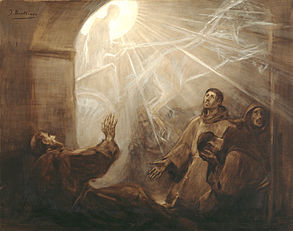
Francis of Assisi visiting his convent while far away, in a chariot of fire, José Benlliure y Gil (1855–1937)
-

The Ecstasy of St. Francis, Stefano di Giovanni, 1444
-

Nazario Gerardi as Francis in The Flowers of St. Francis, 1950
-

Statue in Askeaton Abbey, Ireland, claimed to cure toothache, 14th–15th century
Media
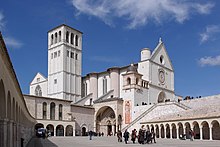 Basilica of St. Francis, Assisi
Basilica of St. Francis, Assisi
 Statue of St. Francis in front of the Catholic church of Chania.
Statue of St. Francis in front of the Catholic church of Chania.
Films
- The Flowers of St. Francis, a 1950 film directed by Roberto Rossellini and co-written by Federico Fellini
- Francis of Assisi, a 1961 film directed by Michael Curtiz, based on the novel The Joyful Beggar by Louis de Wohl
- Francis of Assisi, a 1966 film directed by Liliana Cavani
- Uccellacci e uccellini (The Hawks and the Sparrows), a 1966 film directed by Pier Paolo Pasolini
- Brother Sun, Sister Moon, a 1972 film by Franco Zeffirelli
- Francesco, a 1989 film by Liliana Cavani, contemplatively paced, follows Francis of Assisi's evolution from rich man's son to religious humanitarian, and eventually to a full-fledged self-tortured saint. Francis is played by Mickey Rourke, and the woman who later became St. Clare, is played by Helena Bonham Carter
- St. Francis, a 2002 film directed by Michele Soavi, starring Raoul Bova and Amélie Daure
- Clare and Francis, a 2007 film directed by Fabrizio Costa, starring Mary Petruolo and Ettore Bassi
- Pranchiyettan and the Saint , a 2010 satirical Indian Malayalam film
- Finding St. Francis, a 2014 film directed by Paul Alexander
- L'ami – François d'Assise et ses frères, a 2016 film directed by Renaud Fely and Arnaud Louvet, starring Elio Germano
- The Sultan and the Saint, a 2016 film directed by Alexander Kronemer, starring Alexander McPherson
- In Search of St. Francis of Assisi, documentary featuring Franciscan monks and others
Music
For musical settings of the prayer incorrectly attributed to Francis, see Prayer of Saint Francis § Musical settings.- Franz Liszt:
- Cantico del sol di Francesco d'Assisi, S.4 (sacred choral work, 1862, 1880–81; versions of the Prelude for piano, S. 498c, 499, 499a; version of the Prelude for organ, S. 665, 760; version of the Hosannah for organ and bass trombone, S.677)
- St. François d'Assise: La Prédication aux oiseaux, No. 1 of Deux Légendes, S.175 (piano, 1862–63)
- William Henry Draper: All Creatures of Our God and King (hymn paraphrase of Canticle of the Sun, published 1919)
- Mario Castelnuovo-Tedesco: Fioretti (voice and orchestra, 1920)
- Gian Francesco Malipiero: San Francesco d'Assisi (soloists, chorus and orchestra, 1920–21)
- Hermann Suter: Le Laudi (The Praises) or Le Laudi di San Francesco d'Assisi, based on the Canticle of the Sun, (oratorio, 1923)
- Amy Beach: Canticle of the Sun (soloists, chorus and orchestra, 1928)
- Paul Hindemith: Nobilissima Visione (ballet 1938)
- Leo Sowerby: Canticle of the Sun (cantata for mixed voices with accompaniment for piano or orchestra, 1944)
- Francis Poulenc: Quatre petites prières de St. François d’Assise (men's chorus, 1948)
- Seth Bingham: The Canticle of the Sun (cantata for chorus of mixed voices with soli ad lib. and accompaniment for organ or orchestra, 1949)
- William Walton: Cantico del sol (chorus, 1973–74)
- Olivier Messiaen: St. François d'Assise (opera, 1975–83)
- Juliusz Łuciuk: Święty Franciszek z Asyżu (oratorio for soprano, tenor, baritone, mixed chorus and orchestra, 1976)
- Peter Janssens: Franz von Assisi, Musikspiel (Musical play, text: Wilhelm Wilms, 1978)
- Michele Paulicelli: Forza venite gente (musical theater, 1981)
- Karlheinz Stockhausen: Luzifers Abschied (1982), scene 4 of the opera Samstag aus Licht
- Libby Larsen: I Will Sing and Raise a Psalm (SATB chorus and organ, 1995)
- Sofia Gubaidulina: Sonnengesang (solo cello, chamber choir and percussion, 1997)
- Juventude Franciscana: Balada de Francisco (voices accompanied by guitar, 1999)
- Angelo Branduardi : L'infinitamente piccolo (album, 2000)
- Lewis Nielson: St. Francis Preaches to the Birds (chamber concerto for violin, 2005)
- Peter Reulein (composer) / Helmut Schlegel (libretto): Laudato si' (oratorio, 2016)
Books about Francis (selection)
Hundreds of books have been written about him. The following suggestions are from Franciscan friar Conrad Harkins (1935-2020), director of the Franciscan Institute at St. Bonaventure University.
- Paul Sabatier, Life of St. Francis of Assisi (Scribner’s, 1905).
- Johannes Jurgensen, St. Francis of Assisi: A Biography (translated by T. O’Conor Sloane; Longmans, 1912).
- Arnaldo Fortini, Francis of Assisi (translated by Helen Moak, Crossroad, 1981).
- John Moorman, St. Francis of Assisi (SPCK, 1963)
- John Moorman, The Spirituality of St. Francis of Assisi (Our Sunday Visitor, 1977).
- Erik Doyle, St. Francis and the Song of Brotherhood (Seabury, 1981).
- Raoul Manselli, St. Francis of Assisi (translated by Paul Duggan; Franciscan, 1988).
Other
- In Rubén Darío's poem "Los Motivos Del Lobo" ("The Reasons of the Wolf") St. Francis tames a terrible wolf only to discover that the human heart harbors darker desires than those of the beast.
- In Fyodor Dostoyevsky's The Brothers Karamazov, Ivan Karamazov invokes the name of "Pater Seraphicus", an epithet applied to St. Francis, to describe Alyosha's spiritual guide Zosima. The reference is found in Goethe's Faust, Part 2, Act 5, lines 11,918–25.
- In Mont St. Michel and Chartres, Henry Adams' chapter on the "Mystics" discusses Francis extensively.
- Francesco's Friendly World was a 1996–97 direct-to-video Christian animated series produced by Lyrick Studios that was about Francesco and his talking animal friends as they rebuild the Church of San Damiano.
- Rich Mullins co-wrote Canticle of the Plains, a musical, with Mitch McVicker. Released in 1997, it was based on the life of St. Francis of Assisi, but told as a Western story.
- Bernard Malamud's novel The Assistant (1957) features a protagonist, Frank Alpine, who exemplifies the life of St. Francis in mid-20th-century Brooklyn, New York City.





















